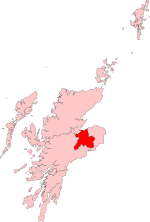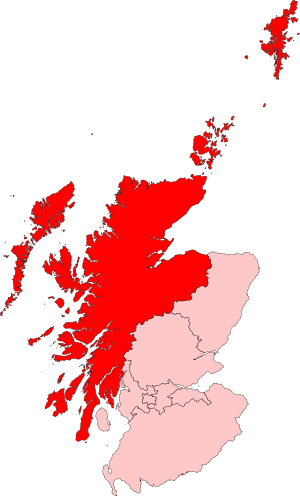Inverness and Nairn (Scottish Parliament constituency) facts for kids
Quick facts for kids Inverness and Nairn |
|
|---|---|
| county constituency for the Scottish Parliament |
|
 |
|

Inverness and Nairn shown within the Highlands and Islands electoral region and the region shown within Scotland
|
|
| Population | 89,755 (2019) |
| Current constituency | |
| Created | 2011 |
| Party | Scottish National Party |
| MSP | Fergus Ewing |
| Council area | Highland |
| Created from | Inverness East, Nairn & Lochaber, Ross, Skye & Inverness West |
Inverness and Nairn is an area in Scotland that chooses one person to represent it in the Scottish Parliament. This special area is called a constituency. The Scottish Parliament, also known as Holyrood, makes laws for Scotland.
The person elected from Inverness and Nairn is called a Member of the Scottish Parliament (MSP). They are chosen using a system called "first past the post." This means the candidate with the most votes wins.
Inverness and Nairn is also part of a larger area called the Highlands and Islands electoral region. This region helps make sure that different political parties are fairly represented in the Parliament.
This constituency was first created for the 2011 Scottish Parliament election. It was formed from parts of two older constituencies: Inverness East, Nairn & Lochaber, and Ross, Skye & Inverness West. Since it was created, Fergus Ewing of the Scottish National Party has been its MSP. He was also the MSP for Inverness East, Nairn & Lochaber before this new constituency was formed.
Contents
Understanding the Electoral Region
The Inverness and Nairn constituency is part of the Highlands and Islands electoral region. This region includes seven other constituencies. These are Argyll and Bute, Caithness, Sutherland and Ross, Moray, Na h-Eileanan an Iar, Orkney, Shetland, and Skye, Lochaber and Badenoch.
This large region covers many different parts of Scotland. It includes most of the Argyll and Bute council area, all of the Highland council area, most of the Moray council area, and all of the Orkney Islands, Shetland Islands, and Na h-Eileanan Siar council areas.
Where is Inverness and Nairn?
The Inverness and Nairn constituency is located within the Highland council area. This council area is represented by three constituencies in the Scottish Parliament. Besides Inverness and Nairn, these are Caithness, Sutherland and Ross and Skye, Lochaber and Badenoch.
The Inverness and Nairn constituency is made up of several smaller local areas called electoral wards. These wards help define the exact boundaries of the constituency.
Electoral Wards in the Constituency
The wards that make up the Inverness and Nairn seat are:
- Inverness West
- Inverness Central
- Inverness Ness-Side
- Inverness Millburn
- Inverness South
- Culloden and Ardersier
- Nairn and Cawdor
- Part of Badenoch and Strathspey
Who Represents Inverness and Nairn?
The person who represents Inverness and Nairn in the Scottish Parliament is called a Member of the Scottish Parliament (MSP). Their job is to speak up for the people in their constituency and help make decisions about Scotland's future.
Since the Inverness and Nairn constituency was created in 2011, it has been represented by Fergus Ewing. He is a member of the Scottish National Party.
| Election | Member | Party | |
|---|---|---|---|
| 2011 | Fergus Ewing | SNP | |
Recent Election Results
Elections are how people choose their representatives. Here's a look at the most recent election results for Inverness and Nairn.
2021 Scottish Parliament Election
In the 2021 Scottish Parliament election, people in Inverness and Nairn voted for their MSP. Here's how the votes were split:
- Fergus Ewing from the Scottish National Party won with 21,793 votes, which was 47.7% of all votes. He continued to be the MSP for the area.
- Edward Mountain from the Scottish Conservatives received 12,679 votes (27.7%).
- Rhoda Grant from the Labour and Co-operative party received 5,370 votes (11.7%).
- David Gregg from the Scottish Liberal Democrats received 2,892 votes (6.3%).
- Ariane Burgess from the Scottish Greens received 2,636 votes (5.8%).
- Other candidates and parties also received votes, but these were the main ones.
In this election, 64.5% of the people who could vote actually did vote. This shows how many people participated in choosing their representative.



